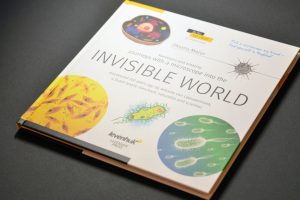The Levenhuk Rainbow 50L Biological Microscope is a premium home-use instrument. Whether for straight up experimentation or educational usage, or for practical tasks like seeing fine detail on a circuit board, the Rainbow 50L is packed with a killer combination of features and added value.

The box.
The lightweight plastic microscope comes in an oversized plastic storage case with snap enclosures. Inside the case are various accessories, a complete Levenhuk K50 Experiment Kit, and a user manual, all of which it also houses, with room for more. I’m reviewing the amethyst (purple) color, but the microscope is also available in equally bold orange, lime, azure (blue), and moonstone (white) hues.

Taking it out of the box.

Opening the case.
The microscope is equipped with three multi-coated glass objective lenses with magnifications of 4x, 10x, and 40x, and which are selected by rotating the revolving nosepiece. Included is a 2x Barlow lens, which, as you might suspect, works to double any of the magnifications. All told, the out-of-the-box magnification range goes up to 800x.
One particularly nice feature of the Rainbow 50L is its built-in double LED illumination system. If you had a similar experience to the one I had all those years ago when still in school, then you probably remember that if we didn’t use transparent slides and ultra-thin samples, then our microscopes weren’t of much use due to lack of light. In fact, that’s what ultimately doomed my own experiments with a cheap microscope I had asked for and received as a child. Fortunately, because of the Rainbow 50L‘s adjustable upper and lower lighting setup, you can not only observe transparent and semi-transparent objects, but also objects that are opaque like a coin or aforementioned circuit board.

Setting up.
Following the instructions in the user’s manual, setup is simple. You move the sample stage to its lowermost position, install the two included AA batteries in the battery compartment beneath the unit (or use the included AC adapter), insert the eyepiece into the eyepiece tube (then into the microscope body, of course), and then adjust the illumination brightness. Finally, you place your specimen on the stage, secure it with the holders, then look through the eyepiece and focus (or further adjust the illumination).

Magnification even using the lowest setting is extremely impressive.
The Levenhuk K50 Experiment Kit is a nice inclusion and makes diving into observations quick and easy because it includes both ready-made experiments, as well as experiments you prepare yourself. The kit comes with a user’s guide, forceps, a hatchery for Artemia (brine shrimp), microtome (tool used to cut thin slices of material), five blank glass slides, dust cover, pipette, four flasks, and five samples. The four flasks contain brine shrimp, yeast, sea salt, and pitch, respectively. The five samples are: fly’s limb, onion, cotton stem, slice of a tree trunk, and pine.

This is a great family activity.
My two oldest daughters, 11 and 9, loved using the kit with the microscope. I’ll almost certainly be buying additional experiment kits for them to use with this once they finish all of the existing activities. It’s definitely a well thought out, well-built, family product that we’ll no doubt continue to make use of in the years to come.
Thanks to Levenhuk for the review unit.




 Your total news and information resource for all things Science, Technology, Engineering / Mathematics, Art, and Medicine / Health.
Your total news and information resource for all things Science, Technology, Engineering / Mathematics, Art, and Medicine / Health.
Leave a Comment